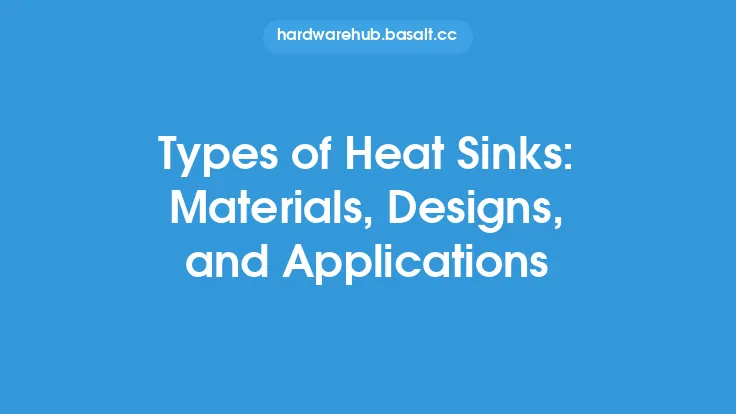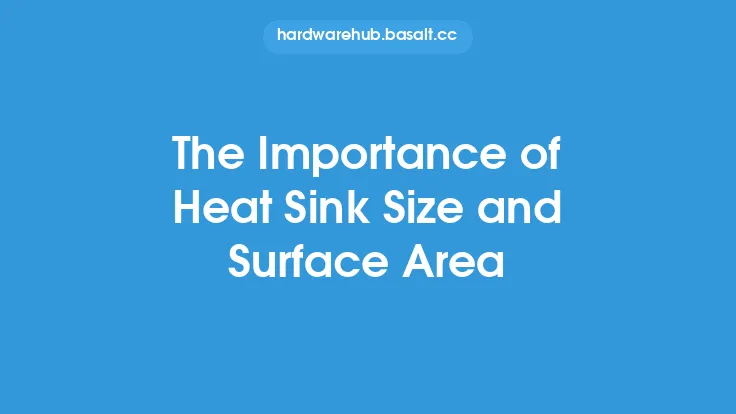When it comes to installing and mounting heat sinks, there are several techniques and considerations to keep in mind to ensure optimal performance and reliability. A heat sink is only as effective as its ability to efficiently transfer heat from the source to the surrounding environment, and proper installation is crucial to achieving this goal. In this article, we will delve into the various heat sink installation and mounting techniques, highlighting the key factors to consider and the best practices to follow.
Introduction to Heat Sink Installation
Heat sink installation involves attaching the heat sink to the heat source, typically a CPU or GPU, using a thermal interface material (TIM) and a mounting mechanism. The goal is to create a secure and efficient thermal interface between the heat sink and the heat source, allowing for maximum heat transfer. There are several types of heat sink installation methods, including clip-on, screw-on, and adhesive-based mounting. Each method has its own advantages and disadvantages, and the choice of installation method depends on the specific application and heat sink design.
Mounting Mechanisms and Techniques
The mounting mechanism is a critical component of heat sink installation, as it provides the necessary pressure and security to ensure a reliable thermal interface. There are several types of mounting mechanisms available, including clips, screws, and springs. Clips are commonly used for CPU heat sinks, as they provide a secure and easy-to-install mounting solution. Screws are often used for GPU heat sinks, as they provide a high degree of pressure and security. Springs are used in some high-performance heat sinks, as they provide a consistent and adjustable pressure.
Thermal Interface Materials (TIMs)
Thermal interface materials (TIMs) play a crucial role in heat sink installation, as they fill the microscopic gaps between the heat sink and the heat source, allowing for efficient heat transfer. There are several types of TIMs available, including thermal tapes, thermal greases, and thermal pads. Thermal tapes are easy to apply and provide a secure bond, but may not be as effective as other TIMs. Thermal greases are highly effective, but can be messy and difficult to apply. Thermal pads are a good compromise between ease of use and effectiveness.
Surface Preparation and Cleaning
Proper surface preparation and cleaning are essential for ensuring a reliable thermal interface between the heat sink and the heat source. The surfaces must be free of debris, oils, and other contaminants that can interfere with heat transfer. A gentle cleaning solution, such as isopropyl alcohol, should be used to clean the surfaces, followed by a dry cloth to remove any residue. The surfaces should also be flat and even, to ensure a secure and efficient thermal interface.
Installation Best Practices
To ensure a successful heat sink installation, several best practices should be followed. First, the heat sink should be handled carefully to avoid damaging the fins or other components. Second, the thermal interface material should be applied evenly and sparingly, to avoid creating air pockets or other defects. Third, the mounting mechanism should be tightened securely, but not over-tightened, to avoid damaging the heat sink or the heat source. Finally, the installation should be inspected carefully to ensure that the heat sink is properly seated and the thermal interface is secure.
Common Installation Challenges and Solutions
Despite the best efforts, heat sink installation can sometimes be challenging. One common challenge is ensuring a secure and efficient thermal interface, particularly with complex or irregularly-shaped heat sources. Another challenge is avoiding damage to the heat sink or the heat source during installation. To overcome these challenges, several solutions can be employed, including using specialized TIMs or mounting mechanisms, or seeking the advice of a qualified technician.
Advanced Installation Techniques
For high-performance or specialized applications, advanced installation techniques may be required. These techniques include using custom-designed mounting mechanisms, or employing specialized TIMs or coatings. For example, some high-performance heat sinks use a phase-change material that melts and solidifies during installation, creating a highly efficient thermal interface. Other advanced techniques include using vacuum-based mounting systems, or employing advanced materials such as graphene or nanomaterials.
Conclusion and Future Directions
In conclusion, heat sink installation and mounting techniques are critical to ensuring optimal performance and reliability in cooling systems. By following best practices and considering the key factors outlined in this article, users can ensure a successful installation and maximize the effectiveness of their heat sink. As technology continues to evolve, new and innovative installation techniques and materials will emerge, offering even greater performance and efficiency. Whether you are a seasoned technician or a DIY enthusiast, understanding the principles and techniques of heat sink installation is essential for achieving optimal cooling performance.





